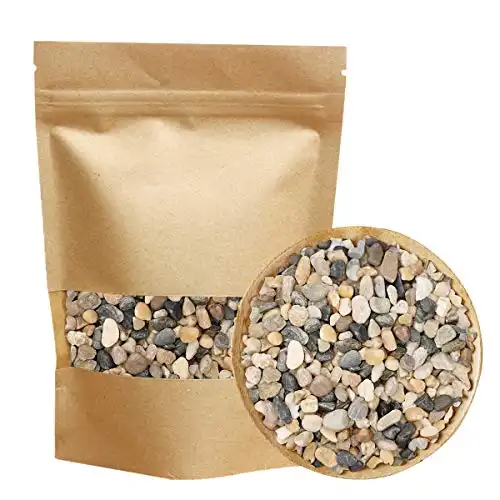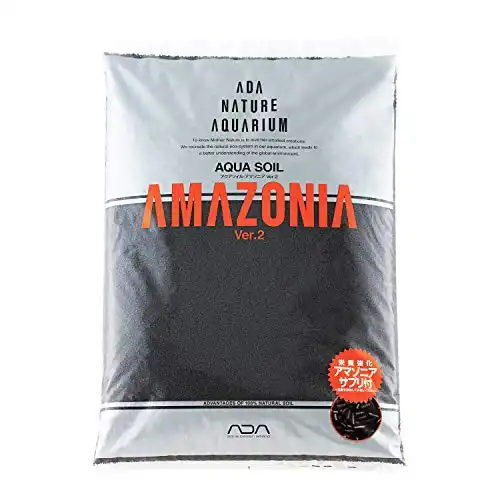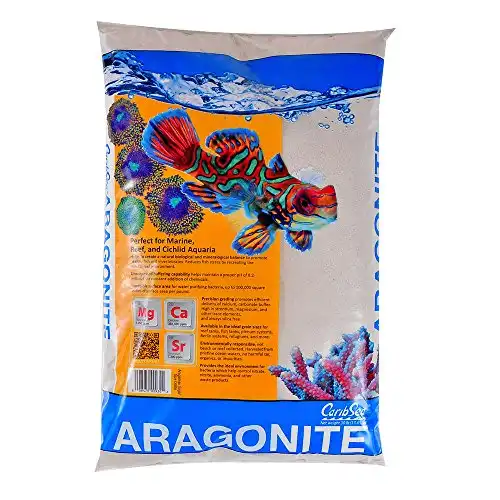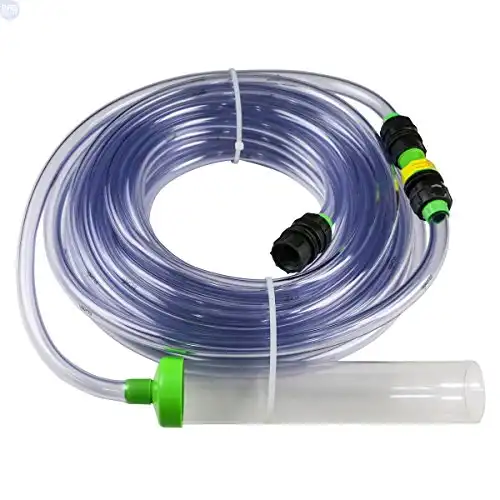Thank you for visiting! By the way… any links on this page that lead to products on Amazon and other stores/partners are affiliate links Aquarium Store Depot earns a commission if you make a purchase.
Believe it or not, your aquarium substrate says a lot about you as a fish owner. Over the years, different substrates have taken the spotlight as being the most beneficial and aesthetically pleasing. While coarse gravels and crushed coral were popular 10 years ago, naturally colored sands and formulated plant soils are seen in most home aquariums today.
But how much does the type of substrate you choose for your aquarium really matter and why?
To understand this question, we need to study the substrate as its own ecosystem.
Key Takeaways
- Substrate is important in the aquarium for keeping healthy populations of beneficial bacteria, providing nutrients, and completing an aesthetic design.
- Some of the most popular types of tank substrates are gravel, sand, and aqua soil. This is especially true when considering substrates for a planted tank setup.
- Substrates can be used to alter water chemistry, like increasing pH, which can help create an environment more suitable for specific fish.
- Tank maintenance includes regularly cleaning the substrate. Sometimes, it may be necessary to supplement or replace the substrate entirely.
What Is It
In the simplest sense, substrate is any material that is put on the bottom of an aquarium. Look further into the definition of substrate, though, and you’ll find that there’s another important aspect: a substrate provides nutrients and/or an environment for organisms to live and grow. That’s right, your substrate can become alive!
Substrates are an important aspect of freshwater and saltwater ecosystems. Similar to a garden, a substrate is alive and full of inert and active compounds, minerals, and processes that are essential for the success of the surrounding environment.
In the aquarium, beneficial bacteria heavily rely on the substrate to live and grow while processing the nitrogen cycle, converting ammonia to nitrite and eventually nitrate. In fact, some deep substrate-dwelling species of anaerobic bacteria are responsible for converting nitrate back into nitrogen gas. In addition to hosting beneficial bacteria, substrates contain many nutrients and minerals essential for plant growth.
Why Do We Add It?
There are many benefits to adding aquarium substrate to a fish tank, though most hobbyists consider its aesthetic appeal first1.
On top of providing an environment for beneficial bacteria to grow and for plants to uptake nutrients, an aquarium’s substrate sets the undertone for the entire appearance of the setup. With so many different types of substrates to choose from, picking the right substrate can be hard.
The most important aspect of picking the right substrate for your aquarium is making sure that it will make your ecosystem the healthiest that it can be. There are many ways a substrate can benefit an aquarium system:
- Provide a healthy environment for bacteria to grow. While most beneficial bacteria live in the filter media of aquariums, some rely on living and reproducing in the substrate. These can be aerobic or anaerobic species, depending on the depth of the substrate bed.
- Provide nutrients. Most aquarium substrates are inert, which means that it isn’t immediately reactive and doesn’t release nutrients or minerals into the water column for plants to use; eventually, all substrates start to erode and release nutrients over time, but this is a very lengthy and inconsistent process. Fortunately, many aquarium substrates, especially those for freshwater aquariums, have started including beneficial additives for supporting plant growth. Otherwise, substrate is very important for storing nutrients that can later be used by a variety of organisms.
- Aesthetic appeal. While not an important aspect that contributes to the health of the aquarium, the aesthetic appeal of aquarium substrate rates highly on most hobbyist lists. There are tons of substrates available, all with different weights, colors, and benefits they can provide to the aquarium. As we’ll see, some of the popular aquarium substrates include gravel, sand, and aqua soil.
The 5 Types Of Aquarium Substrates
Before you can decide which substrate is the best for your aquarium, you need to be aware of all your options. In general, freshwater planted tanks use sand or aqua soil, while saltwater aquariums use sand or nothing at all. For simple freshwater and saltwater aquariums, gravel can also be used. Less popular options are pebbles or larger rocks.
What is the best substrate for fish tanks? Let’s find out. We have video just for you from our YouTube Channel. Our blog also goes into more detail so you can follow along to both.
Not all substrates are equal though, and what works for one hobbyist might not work for the next. The best substrate will be the one that lets your fish live in a healthy ecosystem while also appealing to the creative side of the hobby.
1. Gravel
Gravel is a classic inert substrate that is good to use for many aquarium applications. Many types and colors available.
Is aquarium gravel the same as substrate?
When you think of aquarium substrate, bright, colorful gravel will often come to mind. In fact, gravel substrate was the most popular type of substrate for a long time. While gravel is a type of substrate, it’s not the only aquarium substrate available.
Gravel is available in almost every color, shape, and size and is relatively inexpensive. In addition, gravel is very easy to clean with a gravel vacuum during water changes and can’t get sucked up or kicked up as sand does. However, it is much easier for fish waste and other debris to get caught in between the individual pieces.
There are a few benefits to gravel apart from its low expense, variety, and wide availability. As mentioned, gravel cannot be easily kicked up. This is especially beneficial if dealing with fish, like African cichlids, that like to rearrange the tank or in an aquarium with high water flow.
There are also a few reasons gravel shouldn’t be used, though.
Gravel is generally inexpensive, which means that quality can vary greatly. If opting to go with gravel, make sure it is tumbled or rounded to ensure that sharp edges have been softened. Sharp gravel can injure bottom-dwelling fish and trap more fish waste, leading to unsafe and unhealthy conditions. You can also purchase inert gravel designed for planted tanks called seachem flourite.
In addition, cheap, colored gravel should also be avoided. Unfortunately, many of these gravels that feature bright colors are artificially dyed or coated in epoxy. While these chemicals and additives might not initially harm the aquarium, they will eventually break down and enter the water column and your fish’s bloodstream. When shopping for gravel substrate, make sure to pick natural colors that haven’t been dyed.
Lastly, gravel is not the best substrate for a planted aquarium. Aquarium gravel is heavy and irregular in shape, which makes it difficult for plant root systems to expand and grow. That being said, many live plants can thrive in gravel substrates as long as the individual pieces of gravel aren’t too heavy or compacted.
2. Pebbles
While not as common. Aquarium pebbles are used to create river like bottoms. Best for fish only setups.
Pebbles aren’t usually seen in the home aquarium but are very common to see in a fish’s natural environment. Pebbles are slightly larger than aquarium gravel, but usually much more rounded and flatter. They are usually accompanied by bigger rocks and small boulders in an aquarium display.
Pebbles (or river rock when they are larger) can be used in the same way that gravel can be. Unfortunately, pebbles share many of the same downfalls that aquarium gravel does, including chemical polishing, but there are some benefits to using this natural substrate.
Some aquarium setups have very high rates of flow that simulate the natural environment of the given fish. In these natural habitats, few plants can take hold, and rocks and pebbles are abundant instead. Due to the high flow of water, rocks are quickly eroded.
In the aquarium, pebbles can recreate the conditions of a high water flow natural habitat. Pebbles do not facilitate root growth in planted tanks and can contain some additives, but is a great substrate for more specifically designed aquariums.
3. Sand
Natural sand is excellent for bottom feeder fish to forage around in.
Over the past few years, sand has greatly increased in popularity and become our personal choice for both freshwater and saltwater aquariums.
Sand is one of the most natural-looking substrates available, facilitates root growth, comes in different colors, and is relatively cheap; in fact, play sand can safely be used in most planted aquarium setups. There are a few drawbacks to using sand, though.
One of the main problems with using sand as a tank substrate is that it is difficult to clean. It is very easy to clean the top of a sand substrate, but almost impossible to vacuum past the top layer without taking too much out of the aquarium. This can lead to anaerobic conditions as the sand compacts and dead plant matter and other organic wastes accumulate. Compact soil can also make it difficult for rooted plants to continue growing.
Another problem with sand is that it is easily kicked up and pushed into filtration systems. This is especially true when first added to the aquarium when nothing is weighing the sand down. Luckily, live plants, decorations, and other organic matter start to hold the sand down over time.
That being said, it can be difficult to grow plants in sand initially. This is because plants are naturally buoyant and will not want to stay weighted down in the substrate. There are many ways to overcome this, and once established, the plants will thrive, but the process can be initially frustrating.
Otherwise, sand is one of the best substrate options for planted aquariums and reef tanks, especially if keeping fish or invertebrates that live in or on top of the tank bottom. Especially fine sand also offers the most surface area for bacteria to grow as possible.
4. Aqua Soil
The Best Planted Tank Substrate
The world's standard in active substrates for planted tanks. Created by brand that founded modern aquascaping
Aqua soil is a very popular substrate for advanced planted tank setups. This is a porous, often clay-based substrate that delivers key nutrients to live plants. Two of the most popular types of aqua soil are Caribsea Eco-Complete and ADA Aqua Soil.
However, there is some discussion over how much this expensive substrate actually facilitates plant growth.
In terms of supporting root growth, aqua soil beats most other substrates. This substrate is porous, lightweight, and easy for roots to latch (like carpeting plants) onto and grow through; aqua soil is also heavy enough to initially weigh down plants which eases some of the frustration that typically comes with using sand.
How aqua soil works is a different story, though. Properly made aqua soil is an already nutrient rich substrate that delivers nutrients directly to plant roots and also transfers nutrients out of the water column and into the root system. Either way, aqua soil is recommended for heavy root feeders and carpeting plants.
In most cases, average tank enthusiasts prefer to use other inert, common substrate options that can be used to cap more active substrates.
5. Water Chemistry Changing Types
Boosts pH
Aragamax is great for African setups as it keeps pH and hardness levels stable
Substrate can help a fish tank in more ways than one. Though many aquarium fish require similar water parameters to one another, some fish might need some alterations, like higher or low pH levels. This is especially true for biotope setups, like rift cichlid tanks or Amazonian displays.
Here are some substrate options that can help alter water parameters:
- Aragonite. Aragonite sand is the top choice for reef tank keepers. This common substrate is composed of calcium carbonate, which disintegrates into the water and raises pH and water hardness to typical saltwater conditions. Available in various grain sizes.
- Crushed coral. Crushed coral substrate is similar to aragonite, but is small, sharp pieces of broken-up shells, coral skeletons, and other calcium carbonate structures. While an outdated substrate in the saltwater aquarium, crushed coral is very helpful in freshwater aquarium systems that require higher pH levels.
- Peat moss and granules. Peat moss and granules are often used as a supplement to a substrate. Adding an entire bottom of peat moss or granules could make for a very acidic tank that wouldn’t support fish or plants. Instead, peat can be added to an aquarium substrate to lower pH. Be careful to choose fully organic peat without any additives as chemicals are often used for treatment.
- Vermiculite. Commonly used in home gardening, some hobbyists have had success using vermiculite as part of their substrate. By part, we mean that vermiculite cannot be used alone and does best when capped by other more common substrates. Vermiculite can be tricky to use at first as it doesn’t sink until waterlogged. However, when capped by another substrate, vermiculite can be especially good at retaining nutrients and feeding aquarium plants. The general consensus is that vermiculite works best in large tanks over 100 gallons.
What’s The Best One For You?
With all things considered, what’s the best aquarium substrate for your aquarium?
First, consider if you need to alter water parameters to keep your desired fish, plants, or invertebrates. If catering to specific species, then it might be a good idea to use a substrate to help control water parameters.
Next, consider water flow and the behavior of the given fish. High water flow and inquisitive fish can quickly move around lighter substrates, so a heavier option might be better for these tank setups. If keeping fish or invertebrates that prefer to be on or in the substrate, then it is also strongly recommended to use a fine substrate that won’t injure your tank’s inhabitants.
Lastly, consider personal preference. It is very messy to swap out substrates once a fish tank is established, so you need to be happy with the kind you choose.
Colors And Why It’s Important
While personal preference is important, some science goes behind picking the right color of the substrate. Substrates come in every color imaginable, but only shades of brown as considered the most natural.
That being said, black substrates are very popular due to the contrast they create with fish and aquarium plants. Though aqua soils are rich in nutrients, they are a dark substrate that can expose dirty tanks as uneaten food and other waste easily show up against a contrasting backdrop. Similarly, white substrates will quickly dirty and lose their brand-new appeal.
In general, light colored substrate options should be avoided, including very light natural sand options. This is because they tend to wash out the colors of any fish you choose to keep. Lighter colored substrates also reflect a lot of light, which can be hard to look at for yourself and your fish.
Keep in mind to check any substrate for added chemicals and dyes that could potentially leak out into aquarium water over time.
How Much Do You Need
How much substrate do you need in your aquarium? In general, 1 to 3 pounds of substrate are recommended per gallon of water; one pound per gallon will result in about an inch of substrate at the bottom of the tank.
The end goal should be about 1 to 2 inches of substrate in total. This allows most plants to establish a root system in a planted tank without creating dead zones.
Many hobbyists like experimenting with deep substrate beds that facilitate anaerobic bacterial processes, though this should only be attempted by experts.
Bare Bottom Options And Best Tanks For Them
One substrate option you might not have considered is none at all. Does an aquarium even need substrate?
Not necessarily! Bare bottom tanks are a popular choice among saltwater enthusiasts as purple coralline algae can grow along the bottom of the tank, or GSP can be grown instead. This creates a unique appearance while also keeping the tank clean and easier to maintain.
You will also see bare bottoms in goldfish tanks and discus tanks, even in professional koi ponds. They are a must in hospital tanks.
Maintenance
Keeping a healthy tank means keeping a healthy substrate. No matter what kind of substrate you have, some maintenance will be required to keep waste from building up and anoxic zones from forming.
Most substrates can be regularly vacuumed with an aquarium siphon. This should be done every time or every other time the tank is cleaned. Sand substrates should be lightly siphoned to remove superficial wastes.
The Python is a mainstay in the fish hobby. Easily clean your aquarium by connecting this to your sink!
Some other maintenance you may not have considered is dosing root tabs for root feeding plants and replacing or supplementing substrates that affect water parameters. Eventually, these substrates may exhaust their properties which would stop their effect on water conditions.
Final Thoughts
No matter if you’re starting a planted tank or a full reef display, picking the right substrate for your aquarium can be challenging. Substrates are important for supporting a healthy population of beneficial bacteria, while also providing a natural habitat for fish and plants. There are a few main substrates to choose from, with sand being the most popular in recent years. However, sand can be slightly challenging in a planted aquarium during the initial startup of the system.
I hope this article helps you with purchasing your substrate either online or at your local fish store. Let a comment if you have any experience with substrate you used in the past. We love to hear from our readers!
- About the Author
- Latest Posts
I’m thrilled that you found Aquarium Store Depot! Here you’ll find information on fish, aquariums, and all things aquatics related. I’m a hobbyist (being doing this since I was 11) and here to help other hobbyists thrive with their aquariums! I adhere to a high quality Editorial Process and Review products with real life field usage and practical analysis.












Fascinating infornmation, as always. I’m intrigued to start a bare bottom tank for my outdoor raised goldfish pond.
I’m glad it was helpful. Thank you for your comment